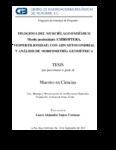| dc.contributor.advisor | Álvarez Castañeda, Sergio Ticul | es_MX |
| dc.contributor.author | Nájera Cortazar, Laura Alejandra | es_MX |
| dc.date.issued | 2013 | es_MX |
| dc.identifier.uri | http://dspace.cibnor.mx:8080/handle/123456789/373 | |
| dc.description.abstract | Myotis peninsularis, es un murciélago endémico a la región de los Cabos, Baja California
Sur, México, para el que actualmente no se tiene clara su situación filogenética. Anteriormente,
era considerado como subespecie de M. velifer. Con la finalidad de conocer su identidad
taxonómica, se realiza un estudio sobre las relaciones filogenéticas de Myotis peninsularis a
partir de datos moleculares y de morfometría geométrica. Se utilizaron dos genes mitocondriales,
el citocromo oxidasa subunidad I (COI) y el citocromo b (Cyt. b). Los análisis filogenéticos
(Máxima Verosimilitud, Máxima Parsimonia, Inferencia Bayesiana, Neighbor-Joining) muestran
que los individuos de M. peninsularis y M. velifer son grupos hermanos, y en conjunto
pertenecen a un clado monofilético. La especie hermana fue M. yumanensis. En el análisis de
distancias genéticas se obtuvieron en promedio porcentajes menores al 2%, valores entre los
intervalos de subespecie. Los análisis de morfometría geométrica demostraron la existencia de
variación en la forma craneal, entre M. peninsularis, dos subespecies de M. velifer y M.
yumanensis. Se obtienen cuatro morfotipos distintos que se corresponden con la distribución de
procedencia. Las diferencias más importantes se ubicaron en la zona de la caja craneal así como
en la robustez del arco zigomático en las tres vistas (ventral, dorsal y lateral). La vista lateral,
fue la más discriminante. La cresta sagital en M. peninsularis es más procumbente en la parte
anterior que la posterior de la caja craneal y M. velifer de forma contraria. La pendiente de la
línea rostral es más abrupta en M. velifer. Morfológicamente, los tres linajes poseen una variación
que tiende a la existente entre las poblaciones mexicanas de M. velifer, pero con morfotipo
específico, asociados a la distribución. En resultados filogenéticos combinados y de
configuración de marcas, la forma ancestral se corresponde con una forma intermedia entre M,
peninsularis y M. velifer; presentando variación similar a la que se muestra intra-específicamente
en M. velifer. Debido a los resultados obtenidos, se propone considerar a M. peninsularis como
una población de M. velifer. | es_MX |
| dc.language.iso | es | es_MX |
| dc.publisher | Centro de Investigaciones Biológicas del Noroeste, S.C. | es_MX |
| dc.title | Filogenia del murciélago endémico Myotis peninsularis (Chiroptera, Vespertilionidae) con ADN mitocondrial y análisis de morfometría geométrica | es_MX |
| dc.documento.id | cibnor.2013.najera_l | es_MX |
| dc.documento.indice | najera_l | es_MX |
| dc.documento.inst | cibnor | es_MX |
| dc.dirtesis.grado | Maestría en Ciencias en el Uso, Manejo y Preservación de los Recursos Naturales | es_MX |
| dc.dirtesis.disciplina | Ecología de Zonas Áridas | es_MX |
| dc.dirtesis.universidad | Centro de Investigaciones Biológicas del Noroeste, S.C. | es_MX |
| dc.dirtesis.facultad | Posgrado en Recursos Naturales | es_MX |
| dc.documento.fecha | Septiembre, 2013 | es_MX |
| dc.description.abstracten | Myotis peninsularis, an endemic bat from the Cape Region, in Baja California Sur, Mexico, has
currently no clear his phylogenetic status. Previously, it used to be considered as a subspecies of
M. velifer. In order to know its taxonomic identity, a study was performed on the phylogenetic
relationships of Myotis peninsularis, from molecular and geometric morphometric data. Two
mitochondrial genes where analyzed: Cytochrome oxidase subunit I (COI) and cytochrome b
(Cyt. b). Phylogenetic analysis (Maximum Likelihood, Maximum Parsimony, Bayesian
Inference, and Neighbor-Joining) shows that M. peninsularis and M. velifer are sister groups, and
together belongs to a monophyletic clade. The sister species was M. yumanensis. In the distance
analysis, average percentages were less than 2%, right between subspecies intervals. The
geometric morphometrics analysis showed the existence of variation in skull shape between M.
peninsularis, two subspecies of M. velifer and M. yumanensis. It was obtained four different
morphotypes, corresponding to their distribution. The most important differences were located in
the area of the braincase and the robustness of the zygomatic arch in the three views (ventral,
dorsal and lateral). The lateral view was the most discriminating. The sagittal crest in M.
peninsularis is more procumbent in the front than the rear of the braincase, while in M. velifer is
in the opposite way. The slope line at the rostral side view is more abrupt in M. velifer.
Morphologically, the three lineages have a tendency to vary as in between Mexican populations
of M. velifer, but each having a specific morphotype, associated to their distribution. In combined
phylogenetic and landmarks configurations results, the ancestral shape correspond to an
intermediate shape between M. peninsularis and M. velifer, showing variation as an intra-specific
variation in respect to M. velifer. Because the results obtained, it is proposed to consider M.
peninsularis as a population of M. velifer. | es_MX |
| dc.documento.subject | Cráneo; filogenia; morfometría geométrica; Myotis peninsularis | es_MX |

